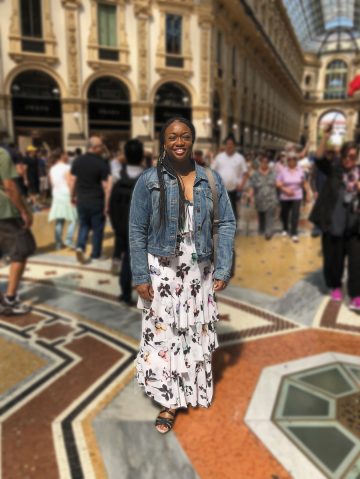Profile with Tashica Williams Amirgholizadeh, Ph.D., J.D. Blending Chemistry and Law
By Christine Suh December 2018/January 2019

When asked where she’s from, Tashica Williams Amirgholizadeh will tell you she’s from all over. Both of her parents served in the U.S. Army, and she spent her childhood moving around. They had one long stint in Germany until she was about 13, when her family moved back to the U.S.
“I just wanted to understand what was going on around me. To this day, that’s how my mind works.”
In school, she discovered she was good at math and
science. What motivated her was the drive to grasp her
surroundings. Recognizing her curiosity, her parents bought her chemistry sets and microscopes to further cultivate her inquisitiveness.
“To me, that was the crux of it,” says Amirgholizadeh. “I just wanted to understand what was going on around me. To this day, that’s how my mind works.”
That desire to comprehend the world led Amirgholizadeh to Baylor University in Texas, where she earned a chemistry degree, with a minor in mathematics, and was awarded a scholarship from the American Chemical Society’s (ACS) Scholars Program that supports underrepresented minorities in chemistry-related disciplines. Clearly on the right path, she then chose to continue her studies at the California Institute of Technology (Caltech) for her Ph.D. She joined the lab of Jacqueline K. Barton, a recent recipient of ACS’ highest honor, the Priestley Medal.
But four years into her doctoral work, she realized academic chemistry research wasn’t for her. Some friends convinced her law would be a great fit, and after earning her Ph.D., Amirgholizadeh pursued a Juris Doctor (J.D.) degree at the University of California-Berkeley, School of Law.
Now, having found her niche, she relishes combining both her chemistry and legal expertise in her work as an attorney for Gilead Sciences, a biopharmaceutical company that develops new medicines. As a patent litigation attorney, she protects the company’s intellectual property assets.
Q&A
[This interview was edited for length and clarity.]

Q: Why did you choose to attend Caltech for your doctorate?
A: When I visited Caltech, it just felt nice and warm. It was small and intimate. And Jackie (Barton) was so enthusiastic about her science, and it got me excited about her science. She had a phenomenal lab with several women, which I very much appreciated. That was a major thrust for her—developing and promoting women.
Q: What led you to transition from chemist to
attorney?
A: Looking back, it was a bit insane. I was in my fourth year there at Caltech, and I was like, I really don’t know if I want to be a researcher.
Up to that point, my life made sense. And after that, it didn’t. But luckily, I had a number of friends in law, and they thought it would be a good fit for me. When I investigated it myself, I was like, yes, this seemed like the right step for me.
Q: On the surface, chemistry and law don’t seem like they have much in common. What skills did you pick up as a chemist that apply to the practice of law?
A: I learned, especially from the Ph.D. program, to see the big picture. I also learned to spot issues, spot problems, and think of creative solutions to those problems. It’s the same thing in law.
Q: In addition to the skillset you developed as a chemist, does chemistry knowledge help you in your capacity as a lawyer?
A: Absolutely. We’re a small molecule company that employs a lot of chemists.
We’re moving into other areas, but that’s where we started from. Being a chemist here has been more than helpful.
I understand where the chemists are coming from.
Q: What advice would you like to pass on to high school students?
A: Don’t limit yourself. If I had followed the straight-line path that every single chemist follows, I wouldn’t be doing something that brings me such joy now. But by allowing myself to explore other options, I found what made sense for me and my life.
Also in this Issue...
Cupping: Harmless Fad or
Sound Science?
By Brian Rohig



